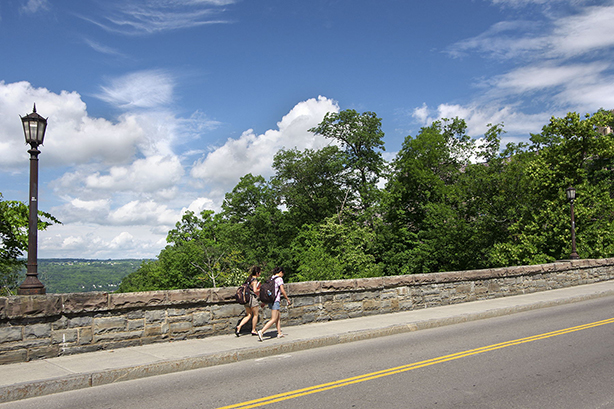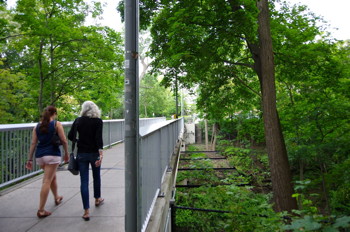COVER STORY SIDEBAR

Pedestrians cross the College Avenue bridge to campus. Photo: Joe Wilensky.
Closing a gap, Cornell installs nets on bridges
Cornell recently closed a significant gap in its otherwise comprehensive mental health and suicide prevention framework: installation of nets under seven bridges on and near campus.
A cluster of suicides during the 2009-10 academic year, three of which involved Cornell students jumping from or near East Hill bridges within a month, prompted the installations. As an emergency measure, temporary fencing was installed on the bridges. Cornell consulted three leading suicide prevention experts who reported that Cornell's comprehensive mental health approach was robust but insufficient in one critical area: restricting access to the bridges as a means of suicide.

People walk across the footbridge connecting Collegetown to campus. Photo: Joe Wilensky. See larger image
While Cornell's overall suicide rate was historically about the same as other colleges and universities, its rate of suicide by jumping was dramatically higher. Nationwide, jumping deaths represent 2 percent of suicides; at Cornell, they accounted for nearly half of all student suicides, said Timothy Marchell '82, Gannett Health Services' director of mental health initiatives. Deaths were not limited to members of the Cornell community but involved members of the wider community as well.
Gannett worked closely with other university administrators and city of Ithaca officials to make the nets a reality. The nets are similar to those approved for San Francisco's Golden Gate Bridge and those installed in Bern, Switzerland, where there have been no bridge suicides or rescues since the first of the nets was installed in 1999. "We are gratified to have these nets in place, which we believe will make vulnerable members of our community safer," Marchell says.